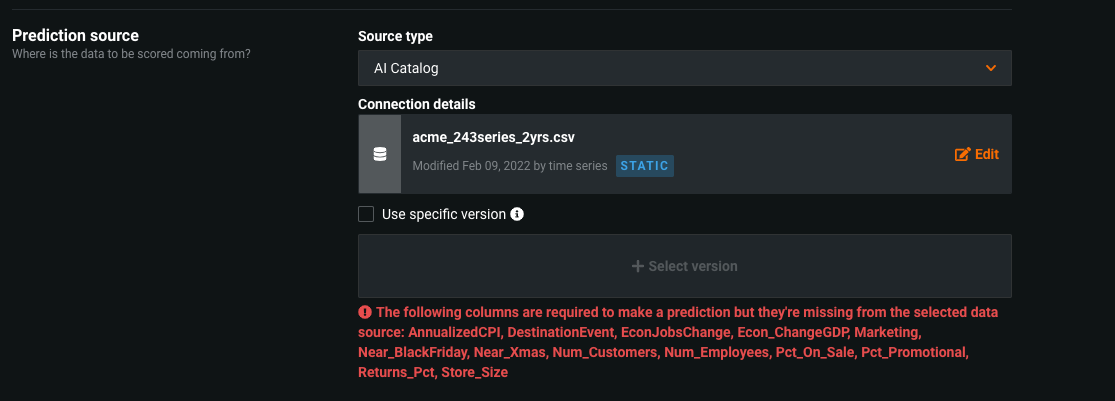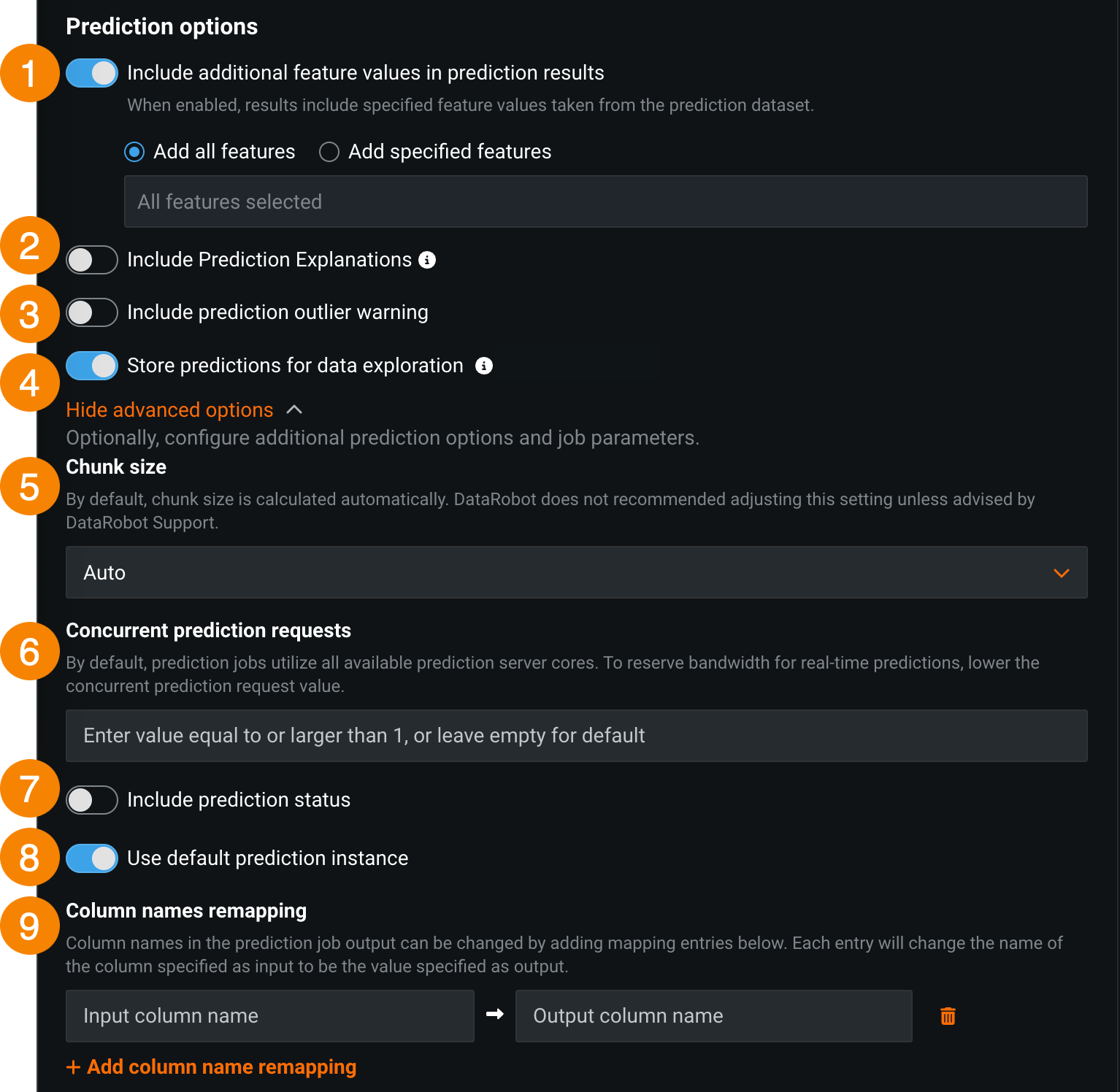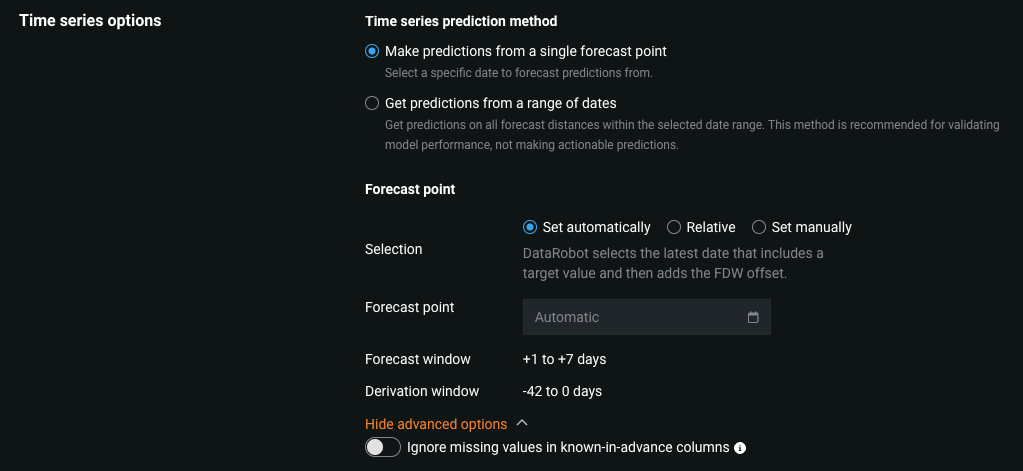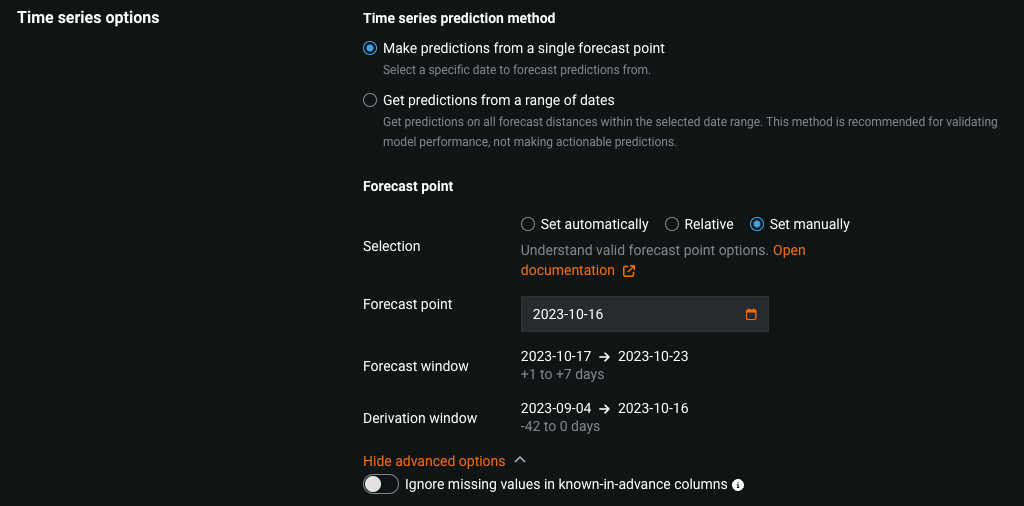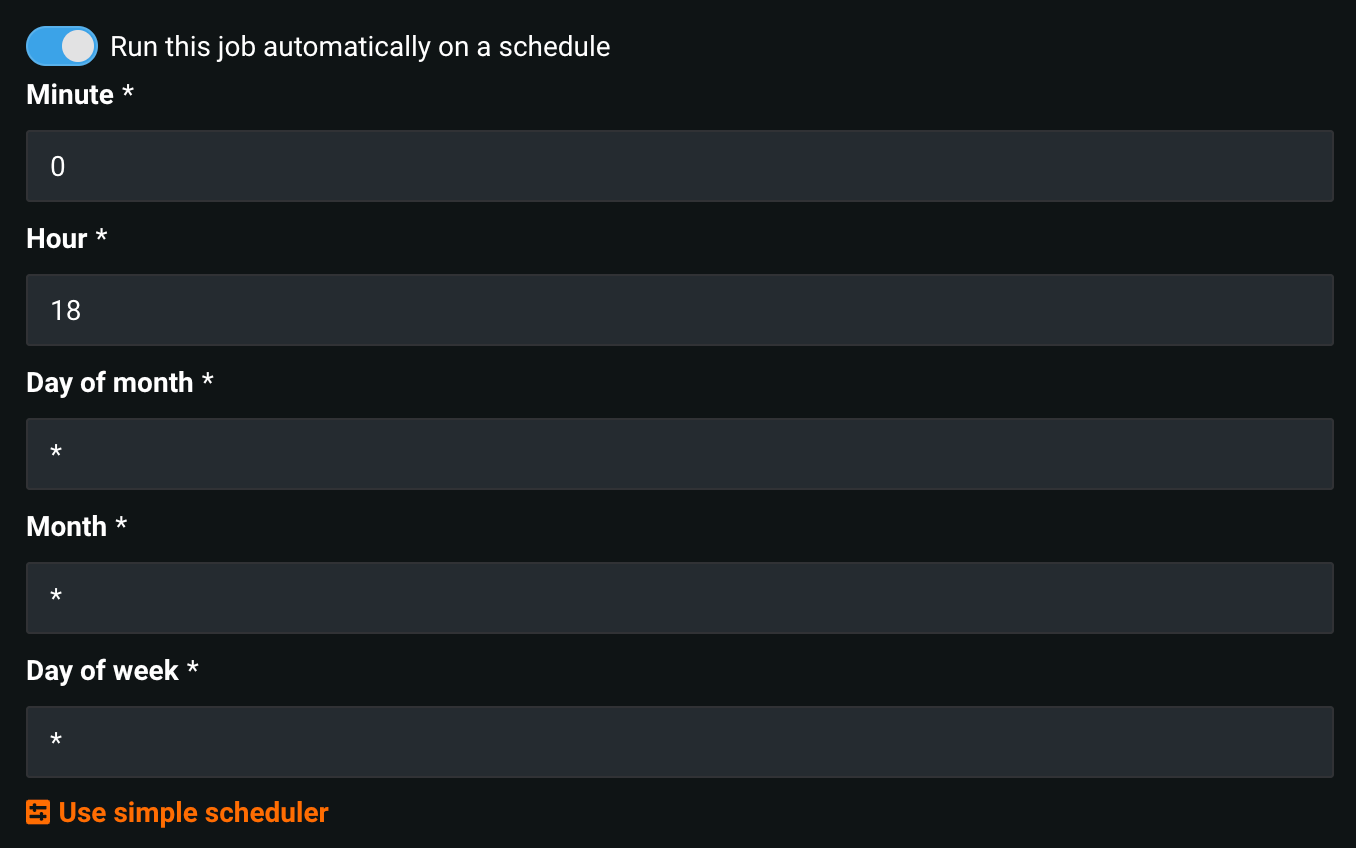Schedule recurring batch prediction jobs¶
You might want to make a one-time batch prediction, but you might also want to schedule regular batch prediction jobs. This section shows how to create and schedule batch prediction jobs.
Be sure to review the deployment and prediction considerations before proceeding.
Create a prediction job definition¶
Job definitions are flexible templates for creating batch prediction jobs. You can store definitions inside DataRobot and run new jobs with a single click, API call, or automatically via a schedule. Scheduled jobs do not require you to provide connection, authentication, and prediction options for each request.
To create a job definition for a deployment, navigate to the Job Definitions tab. The following table describes the information and actions available on the New Prediction Job Definition tab.
| Field name | Description | |
|---|---|---|
| 1 | Prediction job definition name | Enter the name of the prediction job that you are creating for the deployment. |
| 2 | Prediction source | Set the source type and define the connection for the data to be scored. |
| 3 | Prediction options | Configure the prediction options. |
| 4 | Time series options | Specify and configure a time series prediction method. |
| 5 | Prediction destination | Indicate the output destination for predictions. Set the destination type and define the connection. |
| 6 | Jobs schedule | Toggle whether to run the job immediately and whether to schedule the job. |
| 7 | Save prediction job definition | Click this button to save the job definition. The button changes to Save and run prediction job definition if the Run this job immediately toggle is turned on. Note that this button is disabled if there are validation errors. |
Once fully configured, click Save prediction job definition (or Save and run prediction job definition if Run this job immediately is enabled).
Note
Completing the New Prediction Job Definition tab configures the details required by the Batch Prediction API. Reference the Batch Prediction API documentation for details.
Set up prediction sources¶
Select a prediction source (also called an intake adapter):
To set a prediction source, complete the appropriate authentication workflow for the source type.
For AI Catalog sources, the job definition displays the modification date, the user that set the source, and a badge that represents the state of the asset (in this case, STATIC).
After you set your prediction source, DataRobot validates that the data is applicable for the deployed model:
Note
DataRobot validates that a data source is applicable with the deployed model when possible but not in all cases. DataRobot validates for AI Catalog, most JDBC connections, Snowflake, and Synapse.
Source connection types¶
Select a connection type below to view field descriptions.
Note
When browsing for connections, invalid adapters are not shown.
Database connections
Cloud Storage Connections
- Azure
- Google Cloud Storage (GCP)
- S3
Data Warehouse Connections
Other
For information about supported data sources, see Data sources supported for batch predictions.
Set prediction options¶
Specify what information to include in the prediction results:
| Element | Description | |
|---|---|---|
| 1 | Include additional feature values in prediction results | Writes input features to the prediction results file alongside predictions. To add specific features, enable the Include additional feature values in prediction results toggle, select Add specified features, and type feature names to filter for and then select features. To include every feature from the dataset, select Add all features. You can only append a feature (column) present in the original dataset, although the feature does not have to have been part of the feature list used to build the model. Derived features are not included. |
| 2 | Include Prediction Explanations | Adds columns for Prediction Explanations to your prediction output.
|
| 3 | Include prediction outlier warning | Includes warnings for outlier prediction values (only available for regression model deployments). |
| 4 | Store predictions for data exploration | Tracks data drift, accuracy, fairness, and data exploration (if enabled for the deployment). |
| 5 | Chunk size | Adjusts the chunk size selection strategy. By default, DataRobot automatically calculates the chunk size; only modify this setting if advised by your DataRobot representative. For more information, see What is chunk size? |
| 6 | Concurrent prediction requests | Limits the number of concurrent prediction requests. By default, prediction jobs utilize all available prediction server cores. To reserve bandwidth for real-time predictions, set a cap for the maximum number of concurrent prediction requests. |
| 7 | Include prediction status | Adds a column containing the status of the prediction. |
| 8 | Use default prediction instance | Lets you change the prediction instance. Turn the toggle off to select a prediction instance. |
| 9 | Column names remapping | Change column names in the prediction job's output by mapping them to entries added in this field. Click + Add column name remapping and define the Input column name to replace with the specified Output column name in the prediction output. If you incorrectly add a column name mapping, you can click the delete icon to remove it. |
Why can't I enable Prediction Explanations?
If you can't Include Prediction Explanations, it is likely because:
-
The model's validation partition doesn't contain the required number of rows.
-
For a Combined Model, at least one segment champion validation partition doesn't contain the required number of rows. To enable Prediction Explanations, manually replace retrained champions before creating a model package or deployment.
What is chunk size?
The batch prediction process chunks your data into smaller pieces and scores those pieces one by one, allowing DataRobot to score large batches. The Chunk size setting determines the strategy DataRobot uses to chunk your data. DataRobot recommends the default setting of Auto chunking, as it performs the best overall; however, other options are available:
-
Fixed: DataRobot identifies an initial, effective chunk size and continues to use it for the rest of the model scoring process.
-
Dynamic: DataRobot increases the chunk size while model scoring speed is acceptable and decreases the chunk size if the scoring speed falls.
-
Custom: A data scientist sets the chunk size, and DataRobot continues to use it for the rest of the model scoring process.
Set time series options¶
Time series data requirements
Making predictions with time series models requires the dataset to be in a particular format. The format is based on your time series project settings. Ensure the prediction dataset includes the correct historical rows, forecast rows, and any features known in advance. In addition, to ensure DataRobot can process your time series data, configure the dataset to meet the following requirements:
- Sort prediction rows by their timestamps, with the earliest row first.
- For multiseries, sort prediction rows by series ID and then by timestamp, with the earliest row first.
There is no limit on the number of series DataRobot supports. The only limit is the job timeout, as mentioned in Limits. For dataset examples, see the requirements for the scoring dataset.
To configure the Time series options, under Time series prediction method, select Forecast point or Forecast range.
Select the forecast point option to choose the specific date from which you want to begin making predictions, and then, under Forecast point define a Selection method:
-
Set automatically: DataRobot sets the forecast point for you based on the scoring data.
-
Relative: Set a forecast point by the Offset from job time, configuring the number of Months, Days, Hours, and Minutes to offset from scheduled job runtime. Click Before job time or After job time, depending on how you want to apply the offset.
-
Set manually: Set a specific date range using the date selector, configuring the Start and End dates manually.
Select the forecast range option if you intend to make bulk, historical predictions (instead of forecasting future rows from the forecast point) and then, under Prediction range selection, define a Selection method:
-
Automatic: Predictions use all forecast distances within the selected time range.
-
Manual: Set a specific date range using the date selector, configuring the Start and End dates manually.
In addition, you can click Show advanced options and enable Ignore missing values in known-in-advance columns to make predictions even if the provided source dataset is missing values in the known-in-advance columns; however, this may negatively impact the computed predictions.
Set up prediction destinations¶
Select a prediction destination (also called an output adapter):
Complete the appropriate authentication workflow for the destination type.
In addition, you can click Show advanced options to Commit results at regular intervals, defining a custom Commit interval to indicate how often to commit write operations to the data destination.
Destination connection types¶
Select a connection type below to view field descriptions.
Note
When browsing for connections, invalid adapters are not shown.
Database connections
Cloud Storage Connections
- Azure
- Google Cloud Storage (GCP)
- S3
Data Warehouse Connections
Schedule prediction jobs¶
You can schedule prediction jobs to run automatically on a schedule. When outlining a job definition, toggle the jobs schedule on. Specify the frequency (daily, hourly, monthly, etc.) and time of day to define the schedule on which the job runs.
For further granularity, select Use advanced scheduler. You can specify the exact time for the prediction job to run down to the minute.
After setting all applicable options, click Save prediction job definition.


